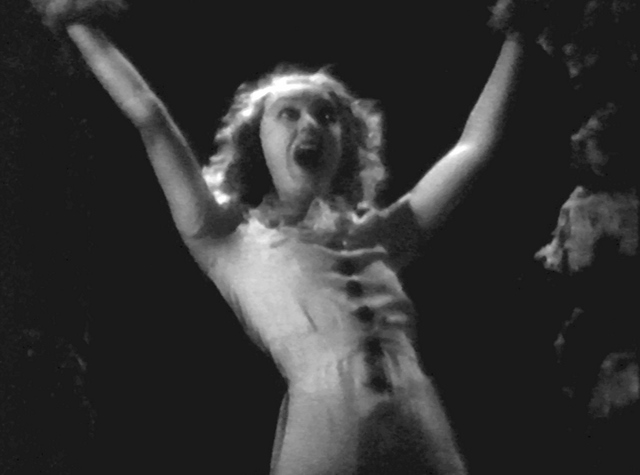MARCH 25, 2008
CINEMA EFFECTS AT THE HIRSHHORN, PART I
On Track to Reverie
On Track to Reverie
By Mark Jenkins

Old Movies, New Views: Fay Wray jerks in Release. (Hirshhorn Museum)
Also this week: PARANOID PARK, THE COUNTERFEITERS,
UNDER THE SAME MOON, SNOW ANGELS, and MILITARY INTELLIGENCE AND YOU!
CONCEPTUAL ART AIMS TO BE OPEN-ENDED, so even the wordy, tripartite title of the Hirshhorn Museum's fascinating current exhibition is overly limiting. The 21 works in "The Cinema Effect: Illusions, Reality, and the Moving Image, Part I: Dreams" (to be followed by "Realisms" on June 19) do mostly involve moving images, and are connected somehow to cinema (or such offshoots as TV, animation, or video games). Yet the show's name seems to say too much, while meaning too little.
Indeed, Kerry Brougher (who co-curated with Hirshhorn film programmer Kelly Gordon) acknowledged at the press preview that some of the artists represented in the exhibition were put off by the proposed title. Their art, they argued, is not about dreams. If there's a fundamental conflict at play here, however, it's not dream versus reality. It's pan versus cut.
The experience begins with Douglas Gordon's Off-Screen, a lighted red curtain that evokes the pop-luxe look of old movie theaters. This is apt for two reasons: The piece is the entrance to dimly lighted galleries full of movies (if no popcorn), and the Scottish artist's 2004 Hirshhorn show is an essential precursor of this one. No moving images are involved in Off-Screen, but many of Gordon's works undermine cinematic "real time" (or "reel time") in a manner akin to such "Cinema Effect" entries as Christophe Giradet's Release. A stuttering remix of Fay Wray's scream upon first encountering King Kong, Giradet's piece prolongs a few seconds of 1930s-style terror for nearly 10 spasmodic minutes.
Release is one of the more striking pieces, but its jerkiness is not typical. The majority of the works are curiously classical — classic Hollywood, that is. Like seminal Fritz Lang and D.W. Griffith pictures, they employ gliding motions and black-and-white palettes. While these mini-movies don't tell traditional stories, they largely reject the post-1950s taste for loud colors, hot noises, and frenetic motion. Gary Hill's Suspension of Disbelief (for Marine) is one of the jumpier ones, but it doesn't bustle all the way to Naim June Park's multi-color hyperactivity (which is well represented a few blocks north at the Smithsonian Museum of American Art). While Hill's corporeal close-ups flicker among 30 video monitors, they're in black and white.
The motion of trains was one of early film's major effects, and it's central also to "The Cinema Effect." Stan Douglas's Overture evokes dreaming and wakefulness with a 7-minute loop of a train (probably in the Sierras) chugging in and out of the blackness of snow sheds; Darren Almond's Geisterbahn ("ghost railroad") gazes from the front of a car slowly traversing a haunted-house thrill ride. Bruce Conner's two films aren't keyed to the rhythms of wheels on rails, but Take the 5:10 to Dreamland — as its title suggests — includes shots of trains.
Many of the most technologically up-to-date pieces also use the fluid motion of the tracking shot. Teresa Hubbard and Alexander Beircher's Eight, the saga of a rained-out birthday party, is one slow and continuous (if brightly hued) take. Chiho Aoshima's City Glow digitally animates Japanese horror and eco-disaster themes, placing them in a five-panel plasma-screen display that suggests a traditional folding screen. City Glow simulates a single take, as does Michael Bell-Smith's Up and Away, a pan through low-pixel-count landscapes harvested from early 8-bit video games. Kelly Richardson's Exiles of the Shattered Star, which looks like a Pink Floyd album cover come to life, is a little cheesy, but it has the elegant pace of a Mizoguchi drama. Those pieces that do employ edits, meanwhile, tend to favor slow dissolves over quick cuts.
The show does include works that don't riff on the conventions of older commercial films. Wolfgang Staehle's Niagara and an excerpt from Andy Warhol's Sleep are both fixed-position shots; they go beyond — or defiantly lag behind — classic-movie stateliness. Three Tony Ounsler pieces project faces or a part of a face (namely, an eye) on lozenges, flirting with sculpture rather than cinema. Anthony McCall's You and I Horizontal uses a haze machine to make projected light visible in mid-air; its connection to movie projection is tangential. Yet even a digital-age exemplar like Siebren Versteeg's Neither Here Nor There has a classic rhythm. It turns pixels into grains of sand, flowing between two images of the same person as though between sides of an hourglass. Time moves slowly in "The Cinema Effect," albeit not so slowly as in Douglas Gordon's 24-Hour Psycho (a molasses-paced version of the Hitchcock flick) or the full 5 hour-and-21-minute Sleep.
There are many possible approaches to "The Cinema Effect: Dreams," of course. But it's striking that the show tacitly defines cinema as urbane, deliberate, and monochromatic. If Lucas, Spielberg, and their successors have inspired art, that's not evident from this collection, which jumps from '40s Hollywood to '80s Nintendo as if they were only a few steps apart. While "Realisms" will surely enlist different precedents, "Dreams" presumes that contemporary moving-image art derives from the first 50 years of cinema, the way so much painting flows from Renaissance canvases. Today's box-office hits make lots of money, but to the artists in this exhibition, they don't add anything to our collective dream-world.
The Cinema Effect: Illusions, Reality, and the Moving Image, Part I: Dreams. To May 11 at the Hirshhorn Museum and Sculpture Garden, 7th St & Independence Ave SW. Free.